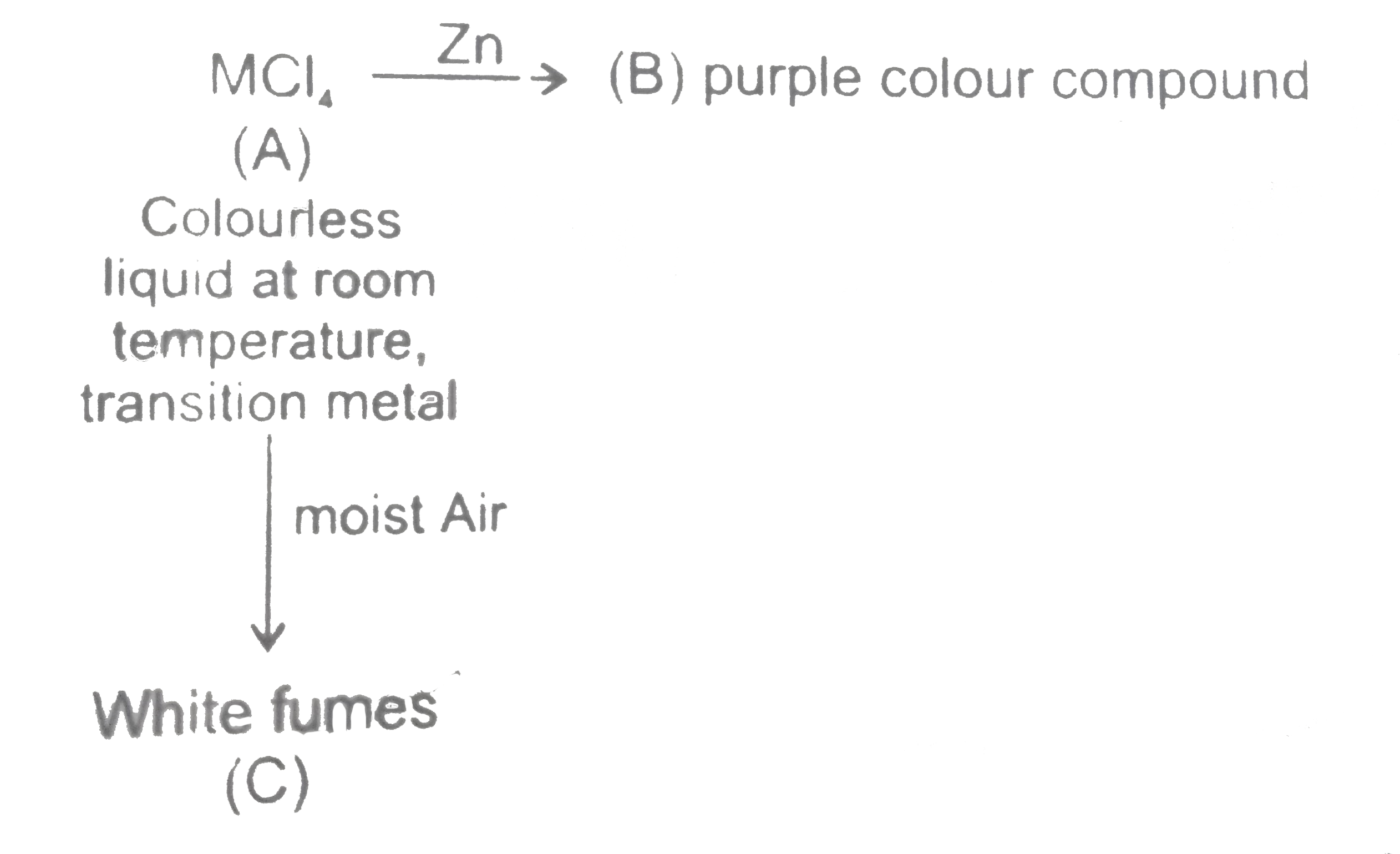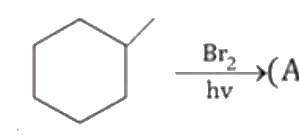BWhite fumeshaving smellMoist air←−−−−MCI4M=Transitionelement colourlessZn−−→APurplecolour
Identify the metal M and hence MCl4. Explain the difference in colour of MCl4 and A.
To solve the problem, we will follow a systematic approach to identify the metal M and the compound MCl4, and explain the difference in color between MCl4 and compound A.
Step 1: Identify the Metal M and MCl4
1. Understanding the Clue: The question mentions that MCl4 produces white fumes when exposed to moist air. This indicates that the compound releases hydrochloric acid (HCl), which is known to produce white fumes.
2. Transition Metal Chloride: Since MCl4 is a transition metal chloride, we need to consider transition metals that can form a +4 oxidation state and produce HCl upon hydrolysis.
3. Identifying the Metal: The metal that fits this description is Titanium (Ti). Titanium forms titanium(IV) chloride, TiCl4, which reacts with moisture to produce HCl and titanium oxide.
Step 2: Reaction with Zinc
1. Reaction with Zinc: When zinc is added to TiCl4 and heated, it reduces titanium(IV) chloride to titanium(III) chloride, TiCl3.
2. Formation of Purple Compound: Upon further reaction with water, TiCl3 can form a purple-colored compound Ti(H2O)6Cl3. This compound is purple due to the presence of unpaired electrons in the Ti3+ ion.
Step 3: Color Difference Explanation
1. Color of MCl4: In TiCl4, titanium is in the +4 oxidation state. The electronic configuration for Ti4+ is (Ar)3d0, meaning there are no unpaired electrons. As a result, TiCl4 is colorless.
2. Color of Compound A: In Ti(H2O)6Cl3, titanium is in the +3 oxidation state. The electronic configuration for Ti3+ is (Ar)3d1, which has one unpaired electron. The presence of this unpaired electron allows for d-d transitions, resulting in the purple color of the compound.
Final Answers
- The metal M is Titanium (Ti).
- The compound MCl4 is Titanium(IV) chloride (TiCl4).
- The difference in color is due to the oxidation states of titanium: TiCl4 is colorless (no unpaired electrons) while Ti(H2O)6Cl3 is purple (one unpaired electron).
2. Transition Metal Chloride: Since MCl4 is a transition metal chloride, we need to consider transition metals that can form a +4 oxidation state and produce HCl upon hydrolysis.
- The compound MCl4 is Titanium(IV) chloride (TiCl4).
- The difference in color is due to the oxidation states of titanium: TiCl4 is colorless (no unpaired electrons) while Ti(H2O)6Cl3 is purple (one unpaired electron).
Topper's Solved these Questions
- QUALITATIVE INORGANIC SALT ANALYSISBOOK - CENGAGE CHEMISTRY ENGLISHCHAPTER - QUALITATIVE INORGANIC SALT ANALYSISEXERCISE - Ex 8.1
14 Videos
- QUALITATIVE INORGANIC SALT ANALYSISBOOK - CENGAGE CHEMISTRY ENGLISHCHAPTER - QUALITATIVE INORGANIC SALT ANALYSISEXERCISE - Ex 8.2
78 Videos
- QUALITATIVE INORGANIC SALT ANALYSISBOOK - CENGAGE CHEMISTRY ENGLISHCHAPTER - QUALITATIVE INORGANIC SALT ANALYSISEXERCISE - Exercises Archives (True/False)
2 Videos
- P-BLOCK GROUP 18 ELEMENTS - THE INERT GASESBOOK - CENGAGE CHEMISTRY ENGLISHCHAPTER - P-BLOCK GROUP 18 ELEMENTS - THE INERT GASESEXERCISE - Ex 5.1 (Objective)
14 Videos
- REDUCTION AND OXIDATION REACTION OF ORGANIC COMPOUNDSBOOK - CENGAGE CHEMISTRY ENGLISHCHAPTER - REDUCTION AND OXIDATION REACTION OF ORGANIC COMPOUNDSEXERCISE - SUBJECTIVE TYPE
4 Videos
Similar Questions
(A)highly reactivewhite solidhas garlic smellburns in−−−−→excess air(B)strongdehydratingagentconc.HNO3−−−−−−→(F)+(C)colourlesssolidI2−−→(D)solid+E(g)
When (C) reacts with NaCl the state of hybridisation of N−atom in the products
View Solution
Identify (A),(B) and (C).
Also explain colour difference between MCl4 and (B).
View Solution
Knowledge Check
(A)SymmetricalKetoneLiAlH4−−−→(B)H⊕−−→ΔDiastereomers
Reactent (A) is :ACH3−O∣∣C−CH3BCH3−O∣∣C−CH2−CH3CCH3−CH2−O∣∣C−CH2−CH3DCH3−CH2−CH2−CH=OPhenol Zn-dust−−−→AConc.HNO3−−−−−−→+H2SO4BZn−−−→NaOHC
in the above reaction A, B and C are :Abezene,nitrobenzene and anilineBbenzene , dinitrobenzene and m-nitroanilineCbenzene, nitrobenzene and hydrazobenzeneDtoluene, m-nitrobenzene nd m-toludine
Consider the given reaction
CH3−CH3∣C∣CH3−CH2−OHconc.H2SO4−−−−−−→ΔAlkene(major)
Identify alkene.
View SolutionPh−CH3KMnO4−−−−→ΔASoda Lime−−−−−→ΔB
Compound B is :
View SolutionC2FClBrl(all isomers) H2−−→Ni(A)(exclude stereoisomer)
(2) C4H8(alkene)(all isomers)H2−−→Ni(B) (exclude stereoisomer)
View Solution Br2−−→hv(A)alc. KOH−−−−→(B)OsO4−−→(C)HlO4−−→(D), Identify 'D'
Br2−−→hv(A)alc. KOH−−−−→(B)OsO4−−→(C)HlO4−−→(D), Identify 'D'
View SolutionCH3−CH3∣CH∣CH3KmnO4−−−−→(A)H+−−→Δ(B)HBr−−−→ROOR(C)
Product (C) in the above reactions is :
View SolutionWhat is Z in the following sequence of reactions?
PhenolZn−−→dustXCH3Cl−−−−−−−→Alhyd. AlCl3YAlkaline−−−−→KMnO4Z Phe
View Solution
